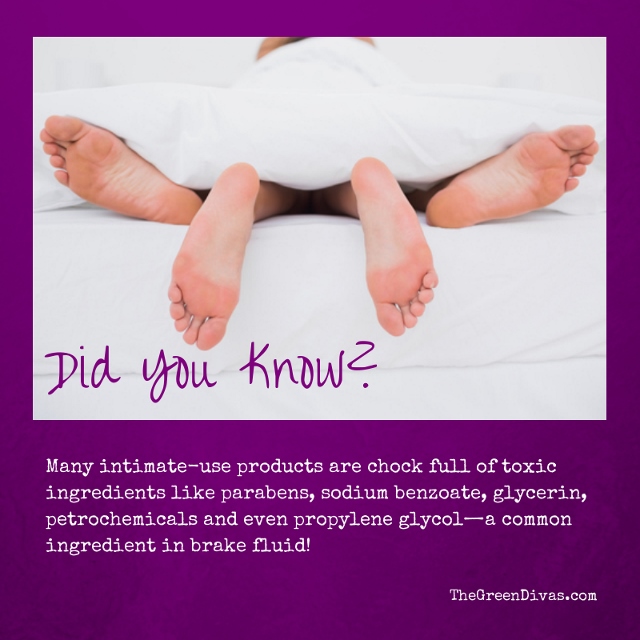Do you know what’s really going on between the sheets (i.e., during sex)?
Many of are conscious about the food we eat and the lotions, creams, ointments and beauty products that come in contact with our skin every day.
Yet our awareness may be a bit skimpy when it comes to potential toxin exposure in the bedroom department. You could be having toxic sex.
Okay, so maybe we’re thinking about other things (when we’re busy getting busy?). But, unfortunately, it’s time we turn those bedroom eyes toward your intimate-use products—most of them are chock full of toxic ingredients like parabens, sodium benzoate, glycerin, petrochemicals and even propylene glycol—a common ingredient in brake fluid!
Recent studies have also shown that many such products—especially personal lubes—can seriously damage the cell lining, potentially enhancing our susceptibility to sexually-transmitted bags o’ fun like gonorrhea, Chlamydia, syphilis, genital herpes, hepatitis B and, of course, HIV. But more on that in a bit.
According to market research firm Iri, Americans plunk down roughly $200 million annually on lube alone, a substance that sort of faces Food and Drug Administration scrutiny but not necessarily in the ways you might expect. That’s because the FDA classifies lube as something “to lubricate a body orifice to facilitate entry of a diagnostic or therapeutic device.” (And if that doesn’t get you all hot and bothered nothing will.)
The problem with classifying lubricants this way, as a de facto medical device, is twofold. First, thanks to the glorious idiosyncrasies of language, such products only face FDA scrutiny if they explicitly portend to be “vaginal lubricants.” Such a stipulation imposes a stipulation that the manufacturer must submit a host of applications (called “510k clearances”) to the FDA. But it doesn’t necessarily mean it has to prove the product is safe for repeat contact.
“The regulatory environment does not appear to always require lubricant manufacturers to rigorously confirm the vaginal and rectal safety of these products,” says Scott Giebel, an associate with the Population Council’s HIV and AIDS program, “especially if the product does not claim to be intended for sexual use.”
Second, companies that don’t explicitly state their products are intended for vaginal lubrication—even if everybody knows they are—face barely any regulation at all. So, unless people’s junk starts spontaneously bursting into flames after rubbing on some Liquid Sexy Heat, most manufacturers just keep on peddling.
From a toxicity perspective, we know that many intimate-use products currently on the market (most of which come from China, by way of Unregulatedville) contain a host of parabens. Parabens are known endocrine disruptors, and endocrine disruptors have, for some time, been linked to birth defects, reduced sperm count, tumors, immune deficiencies and a seemingly endless list of nasty business, like the “feminization of boys.”
Furthermore, while the U.S. lags behind regulating the toxins we come in contact with, the entire European Union is seeking to ban parabens in any product meant for children under six years old. Officials at the World Health Organization, meanwhile, have stated outright that endocrine disruptors can potentially lead to “obesity, infertility or reduced fertility, learning and memory difficulties, Type 2 diabetes and cardiovascular disease, as well as a variety of other diseases.”
“We don’t have categorical proof that the toxic substances found in (these products) will kill you,” admits Dr. Peter Anton, who recently co-authored an in-depth study on lubricant use. “But if you could easily avoid them why wouldn’t you?”
The results of Anton’s study, which was conducted in Baltimore and Los Angeles as part of UCLA’s Microbicide Development Program, also place rather frightening focus on a little-known lubricant property called “hyperosmolarity.”
In layman’s terms, something that is hyperosmolar contains more salts, carbohydrates and proteins than are normally at home inside the vagina or rectum. This imbalance causes cells to “bleed” water and severely dehydrates the cellular lining. Consequently, the skin can be more susceptible to tears during sex, which fact made the UCLA team conclude that…
“some lubricant products may increase vulnerability to sexually-transmitted infection.”
A similar study conducted in 2012 by the Microbicide Trials Network came to a similar conclusion—though no one has yet confirmed the full extent of damage hyperosmolar lubricants cause. Cellular toxicity was clearly increased by the use of such lubes, especially in the destruction of lactobacillus (bacteria that maintains a healthy genital tract). But the damage incurred did not “appear to make cells more vulnerable to HIV infection.”
“Much more work needs to be done to explore the safety of lubes,” says MTN’s lead author, Dr. Charlene S. Dezzutti. “This was an early study, and the jury is still out.”
While we wait for the jury, how do we know if a lube is hyperosmolar before we buy it? The answer, aside from building personal laboratories in our basements, is we really don’t. Water-based lubes tend to be the biggest culprits, but merely being water-based doesn’t mean a lube is inherently bad for you. In fact, most medical professionals recommend water-based lubes because they clean up easily and are safe on latex.
Silicone-based products, meanwhile, can be a drippy mess and can also damage any toys you bring to the party, while petroleum products not only eat away at rubber and latex, but also trap myriad bacteria that can potentially lead to infection.
So the answer, really, is that everyone is different:
- Look for natural products that clearly list their ingredients. Chances are if you can’t pronounce it you don’t want to screw around with it.
- Typically avoid anything shipped from overseas.
- Never assume any topical product will help protect you from disease.
- Talk to your doctor. That’s what doctors are there for.
- Experiment! Then experiment some more!
Please check out our YouTube channel to see our short, funny and useful 1 GD Minute videos with recipes and DIY tutorials. Here’s a recent one…
And if you want to learn more about the content of this video, please read the corresponding post!
Adapted from HoneyColony article “When Sex Goes Toxic” by Jayson Charles Matthews. Published with permission.
 Jayson Charles Matthews, Editor-At-Large for HoneyColony.com, spent much of his early life in the woods of Mendocino playing with action figures and stealing gas from his father’s shed, which he then used to devise explosive reenactments of lesser-known Star Wars battles. His professional exploits since have included mad copy editing at megalithic PR conglomerate PR Newswire, running the show at the Silicon Valley bureau of Internet.com, and guiding the content build-out of travel and entertainment company Party Earth.
Jayson Charles Matthews, Editor-At-Large for HoneyColony.com, spent much of his early life in the woods of Mendocino playing with action figures and stealing gas from his father’s shed, which he then used to devise explosive reenactments of lesser-known Star Wars battles. His professional exploits since have included mad copy editing at megalithic PR conglomerate PR Newswire, running the show at the Silicon Valley bureau of Internet.com, and guiding the content build-out of travel and entertainment company Party Earth.
Bed image via shutterstock
Single beds image via shutterstock
Kissing in bed image via shutterstock

Katherine
March 17, 2014 at 10:17 pm
We found an organic lubricant years ago and love it despite it’s cost. It’s from Firefly Organics and so pure, it’s practically edible.
http://fireflylubricant.com/
Green Diva Lynn
March 20, 2014 at 9:39 am
Thanks for the tip, Katherine!
Pingback: The Secrets of Happiness in Love. {Infographic & Video} | Health & Wellness Chicago
eric weiss md
March 23, 2014 at 9:21 pm
I agree with everything in this post. I have been studying “lubes” for the last 6 years. My research and my degree in chemistry led me to my own product and company. Love Lotion is all natural, free from all harsh chemicals and preservatives, condom and toy compatible, kills yeast and bacteria, and blends fun, romance, sex, and luxury. See it for yourself http://www.lovelotion.com
Eric Weiss MD